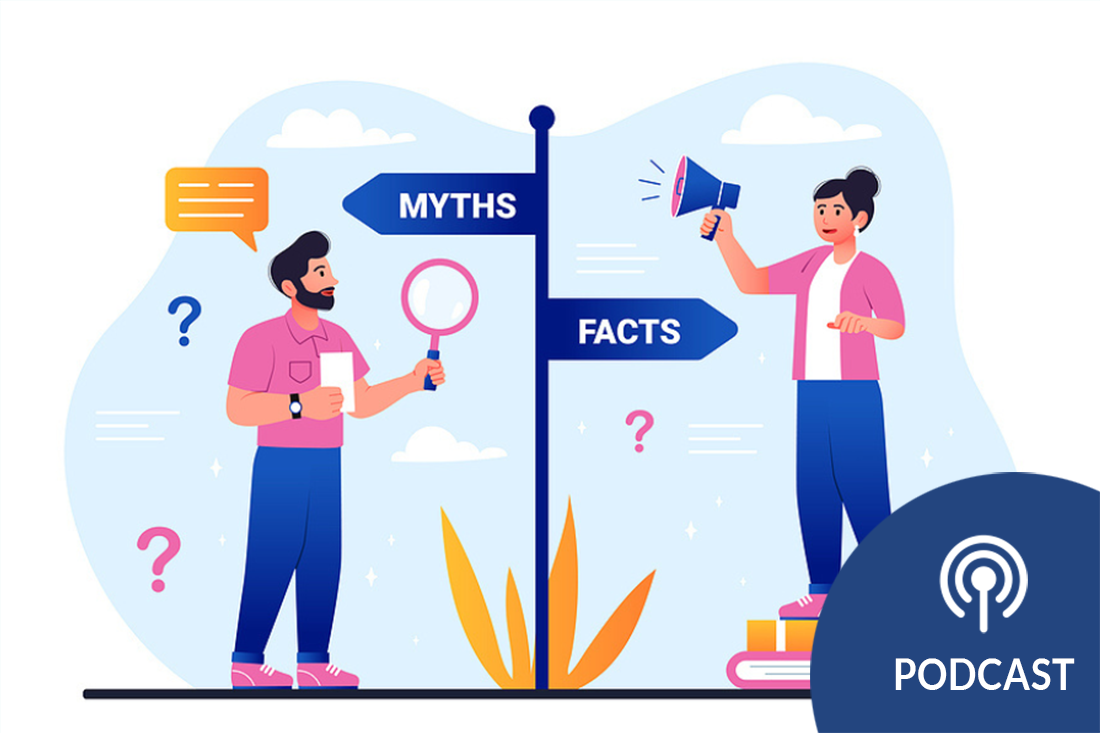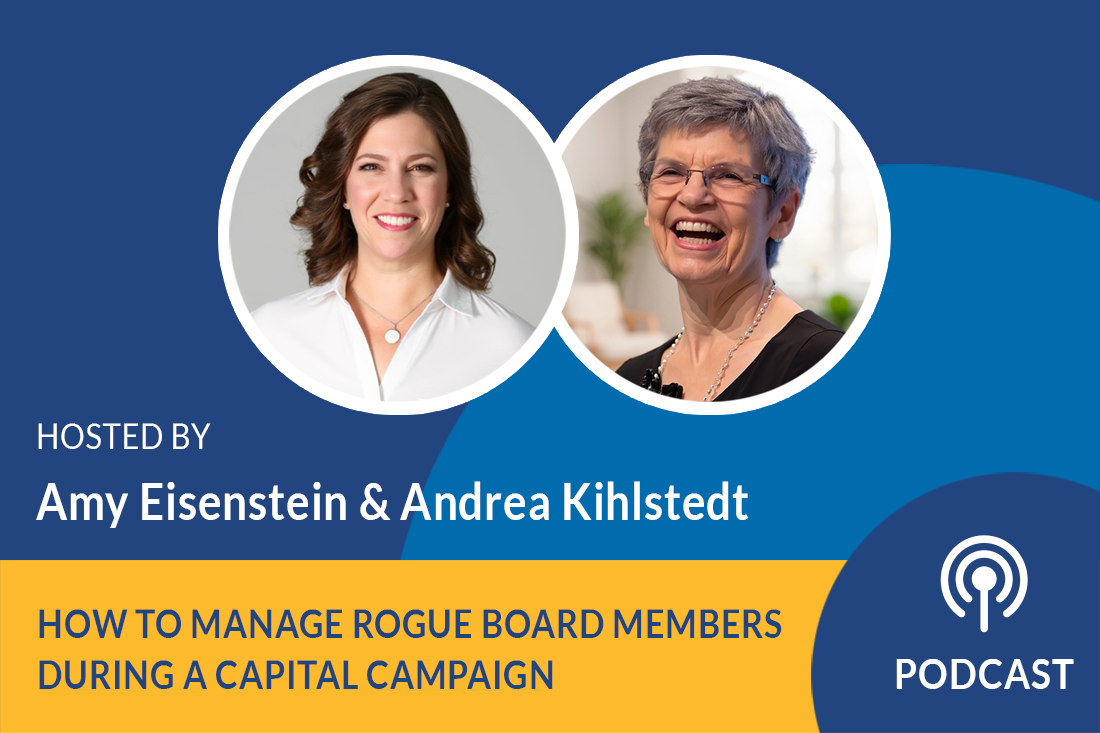Podcast: How Board Members Deceive Themselves Prior to a Campaign?

Season 2, Episode 73
Most board members don’t know much about capital campaigns and what they do know is probably wrong. In this episode, you’ll learn some standard misconceptions.
Listen Now:
Amy Eisenstein:
Are your board members dead wrong when it comes to capital campaigns? They may have no idea what to expect. Today we are going to confront those misconceptions.
Hi, I’m Amy Eisenstein. I’m here with my colleague and co-founder, Andrea Kihlstedt. Today we are talking about how board members deceive themselves about what to expect from a capital campaign, and some of the myths they may believe.
So, Andrea, kick us off. What is the first myth we’re going to talk about?
Misconception #1: A Rich and Famous Person Will Carry Your Campaign
Andrea Kihlstedt:
Amy, the most common myth I think, is that somehow a biggest amount of money for a capital campaign is going to come from some very rich person somewhere, like Bill Gates, or Oprah Winfrey, or Elon Musk, or whoever. You name a very rich person, somehow that very rich person is going to ride in on a white horse and give a huge gift to their campaign.
Amy Eisenstein:
MacKenzie Scott.
Andrea Kihlstedt:
MacKenzie Scott. Yes, she’s the newest —
Amy Eisenstein:
Yes. She’s going to drop from the sky and bestow millions of dollars on your campaign. I mean, she’s doing that, but the gifts are fewer and far between than they may seem. So, you can’t rely on that.
Andrea Kihlstedt:
Chances are, that’s just plain old not going to happen. It’s just not going to happen. So, if it happens, that’s great. But you can’t build a campaign based on that. The sooner your board members understand that, the sooner they’re going to roll up their sleeves and get to work, and get serious about a capital campaign.
Amy Eisenstein:
Just to emphasize that. I mean, even if your board members don’t believe that money is going to drop from the sky, they may think that the money is somewhere out there, someone that you don’t yet know. That somewhere magical out in the community there is going to appear an angel, that is going to come along and save your community, your campaign.
So, really the important thing to help board members understand is to focus inward on the existing donors, on your current board members, on former board members. But people who are very closely aligned, existing donors to your organization.
Misconception #2: Gifts Are All Roughly Equal in Size
Andrea Kihlstedt:
So, the [next] misconception, and the opposite of the first one, is that the money is going to come in in equal amounts. So, if you want to raise a million dollars, that if you just get 100 $10,000 gifts, your campaign’s going to be done.
Amy Eisenstein:
That’s right.
Andrea Kihlstedt:
The first misconception is that somebody very, very rich is going to drop a very, very big gift on your organization. That’s wrong. The other one is that nobody’s going to drop a very big gift on your organization, but they’re going to drop lots of these much smaller gifts. In even amounts.
Amy Eisenstein:
In even amounts, that if everybody just gives $10,000, everybody on your board and every volunteer and everybody on the campaign committee, if 100 people just gave $10,000 each, you’ll get to your campaign goal. Campaigns certainly do not work that way either.
Andrea Kihlstedt:
The connected misconception is, if we just had bricks, $10,000 bricks, and we put them around our new building, the people are going to give $10,000 a brick, and the campaign’s going to be done. Well, good luck with that.
Do you know how hard it is to get that many people to give $10,000? You have to have a really big donor file of people who already give you significant amounts of money to pull something like that off, and chances are you don’t come close.
So, that’s misconception number two. What’s misconception number three, Amy?
Misconception #3: Our Current Staff is All We Need
Amy Eisenstein:
Misconception number three is that the current staff, the development director, is just going to do it all. Without any additional help or resources from the board, or any additional staff or consultants, that the campaign’s just going to magically come together with the existing staff.
Somehow, we like to joke, that maybe the existing staff is sitting around twiddling their thumbs, and they have extra time to raise an extra $2 million, or $5 million. I’m being a little obnoxious here, but the board members who think that they don’t have to provide any support, or connections, or additional resources, or staff up, that’s the misconception — that the organization can just do it with existing resources, and that board members don’t need to help because the staff is just going to do it.
Andrea Kihlstedt:
I think many board members have very little idea of how much work it is to raise the annual fundraising. They don’t know. They’re often not very involved in that, and they simply don’t understand what it takes to put on a big gala event, for example. They don’t understand how the development staff is spending their time, and it looks to them like, well, that’s what we hire them for. We’re going to have a million-dollar campaign.
Well, okay, whatever your development staff name is. It’s up to you. But when the development staff comes back and says:
“Well, we’re going to need additional staff to make this happen.”
Then, the board is surprised [to hear that].
Amy Eisenstein:
Right. The reality is we do want board members involved and engaged in the campaign, and somehow they know that and they’re hoping that maybe they can just sneak by with what they do normally — which is maybe not help so much with the annual fund or the fundraising.
So, the assumption is that things can continue as they are. That board members can just show up for a meeting once a month or once every other month, approve the minutes and move on with their life. So, a campaign’s a bit more involved.
Andrea Kihlstedt:
So, Amy, we’re going to do a fourth misconception, but let me put a little structure on this…
- The first misconception is they were looking for someone [famous] with a lot of money.
- Second misconception is that they’re looking for all the smaller donors in town.
- The third misconception is that they’re looking at the development director/staff to do it all.
The fourth misconception has to do with what the board’s role is in doing this. Now, here we’re getting closer to home, and here we’re getting closer to reality, actually.
So, what’s our fourth misconception, Amy?
Misconception #4: Board Members Are Expected to Produce HUGE Gifts
Amy Eisenstein:
The fourth misconception is that board members will be expected to give bigger gifts than perhaps they can. Or they’ll be asked for enormous gifts, or they really don’t know what gifts they’re going to be asked for. So, it’s a source of anxiety, and that they’re going to have to ask their friends for big gifts as well. Neither of those two things are really the case.
In most campaigns, board members are expected to give a significant and meaningful gift for their own personal budget. But not well over whatever that is. So, board members, yes. Board members are expected to give, but they’re not expected to go bankrupt or even do something that’s way out of their means or their range.
The second thing is that while we do want board members to make connections with people who would care about the cause, would be interested in the campaign, there is no expectation that board members who are uncomfortable and unprepared, go out and ask for significant gifts. So, let’s put those myths to bed.
Andrea Kihlstedt:
Those are four pretty common myths. It’s a rare board that someone on that board doesn’t believe some of those four misconceptions. The question really is, how do you help your board understand the reality of capital campaigns, and not be left with these misconceptions? What are the things someone can do to help their board?
Amy Eisenstein:
Well, as a starter, the easiest thing to do is go to Capital Campaign Pro website, and download our Board Members Guide to Capital Campaigns, and it’s in the resources section of our website. It’s free and it’s downloadable, and it talks about every single one of these things that we mentioned. So, you can circulate this Board Members Guide to Capital Campaigns, that you can find on our website.
The other thing, of course, is ongoing board training. We like to think about ongoing learning opportunities, training for your board for a capital campaign should not be, and is not, a one and done exercise. It’s something that should be discussed at every single meeting for months, and maybe years, leading up into the beginning parts of a campaign.
Now, here at Capital Campaign Pro, our clients do receive both ongoing board training and one-off board trainings, as part of our service. So, if you are thinking about a campaign and you’re not sure where to get started with your board, I would encourage you to call on us and we’d be happy to discuss how we help board members overcome some of these myths.
I hope you learned something and enjoyed listening to us, and we will see you next time.



Leave a Comment